Chitkul: An Ultimate Travel Guide (Updated 2024)
- Travel Guides
-
Oct 16
- Share post
Are you ready for an adventure of a lifetime? Look no further than Chitkul, the hidden gem in the heart of the majestic Himalayas. With its breathtaking landscapes, untouched beauty, and rich cultural heritage, this remote village has everything to offer even the most seasoned traveller.
But before you embark on this journey of a lifetime, join us as we unveil “The Ultimate Travel Guide to Chitkul: How to Reach, Where to Stay, and Things to Do.”
Whether you’re an adrenaline junkie seeking thrilling treks or a nature lover yearning for tranquillity, this comprehensive guide will ensure your trip is extraordinary.
Table of Contents
ToggleIntroduction to Chitkul
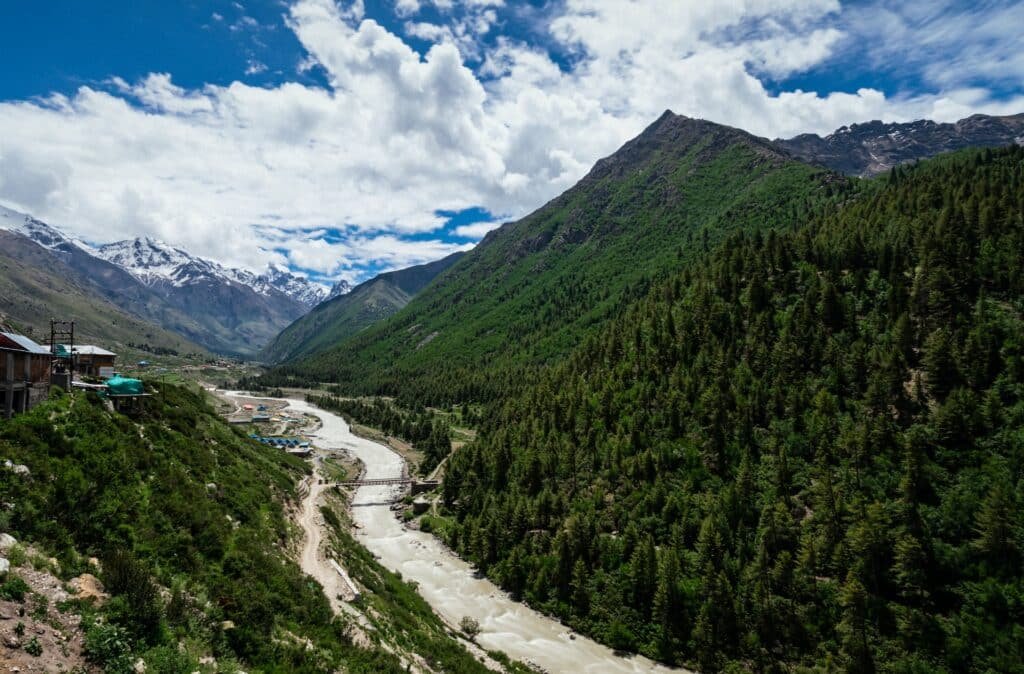
Chitkul, also known as the “Last Village of India“, is a small village located in Kinnaur district of Himachal Pradesh. This quaint village is 11,320 feet above sea level and is the last inhabited settlement on the Indo-Tibetan border. The village is surrounded by snow-capped mountains, scenic valleys, and gushing rivers, making it a perfect destination for nature lovers and adventure enthusiasts.
One of the main reasons the village has gained popularity among travellers is its unique charm that sets it apart from other tourist destinations. This remote village has retained its traditional way of life and cultural heritage despite being exposed to modernization. The locals here are warm and welcoming, giving visitors a glimpse into their simple yet fascinating lifestyle.
In recent years, Chitkul has gained popularity among offbeat travellers as it offers a peaceful escape from the chaos of city life. The village has limited tourist infrastructure, which adds to its rustic charm and makes it an ideal destination for those seeking a break from their busy lives.
How to get to Chitkul
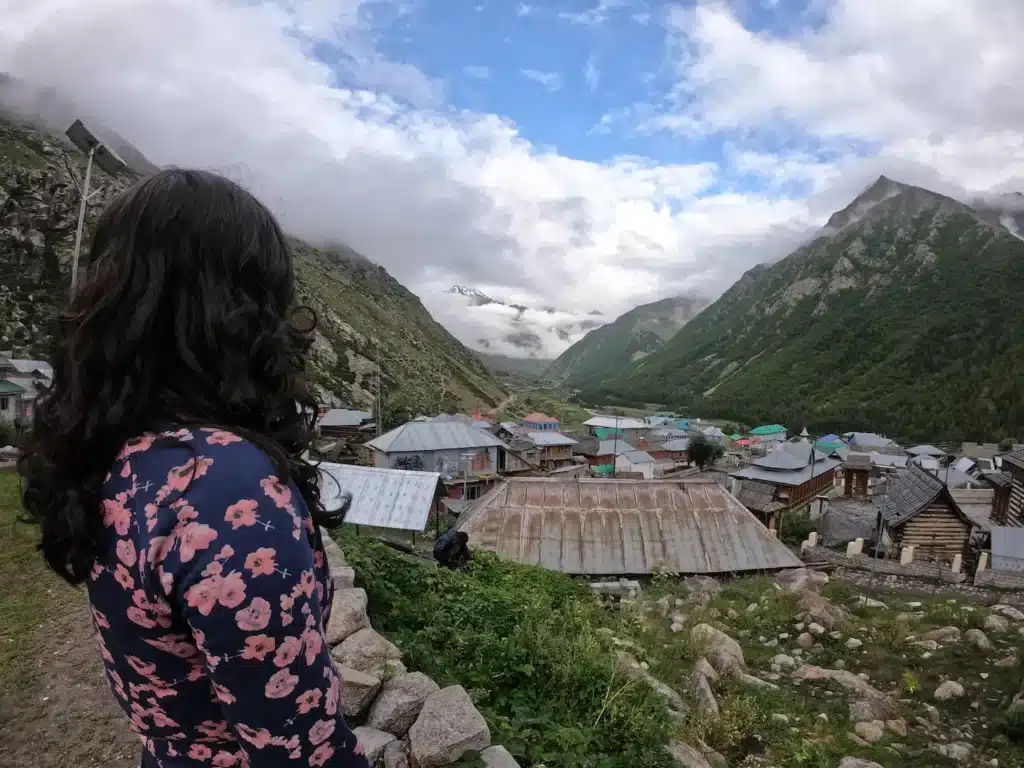
Getting to Chitkul can be challenging due to its remote location. This section will discuss the various transportation options and routes available to reach this beautiful destination.
By Road
The most convenient way to get to Chitkul is by road. The town is well-connected with major cities like Delhi, Chandigarh, and Shimla via buses operated by Himachal Pradesh Tourism Development Corporation (HPTDC) and private bus operators. The roads are well-maintained but can be narrow and winding in certain parts, so it’s best to travel during daylight hours.
Suppose you’re travelling from Delhi or Chandigarh. In that case, you can take an overnight bus that will drop you off at Reckong Peo. You can hire a taxi or take another local bus to reach Chitkul.
By Train
The nearest railway station to Chitkul is in Shimla, around 230 km away. From Shimla, you can hire a taxi or take a bus to Reckong Peo and then follow the above route.
By Air
The nearest airport to Chitkul is in Bhuntar, Kullu, around 240 km away. You can hire a taxi or take a bus from the airport to Reckong Peo and then follow the above route.
Self-Drive
Suppose you’re an experienced driver and want to explore the mountains independently. In that case, you can rent a car from Delhi or Chandigarh and drive up to Chitkul. The route is scenic but challenging, with narrow roads and steep inclines.
No matter your transportation mode, reaching Chitkul will be an adventure. Plan your journey well in advance and check for any road closures or weather conditions before starting your trip.
Best time to visit Chitkul
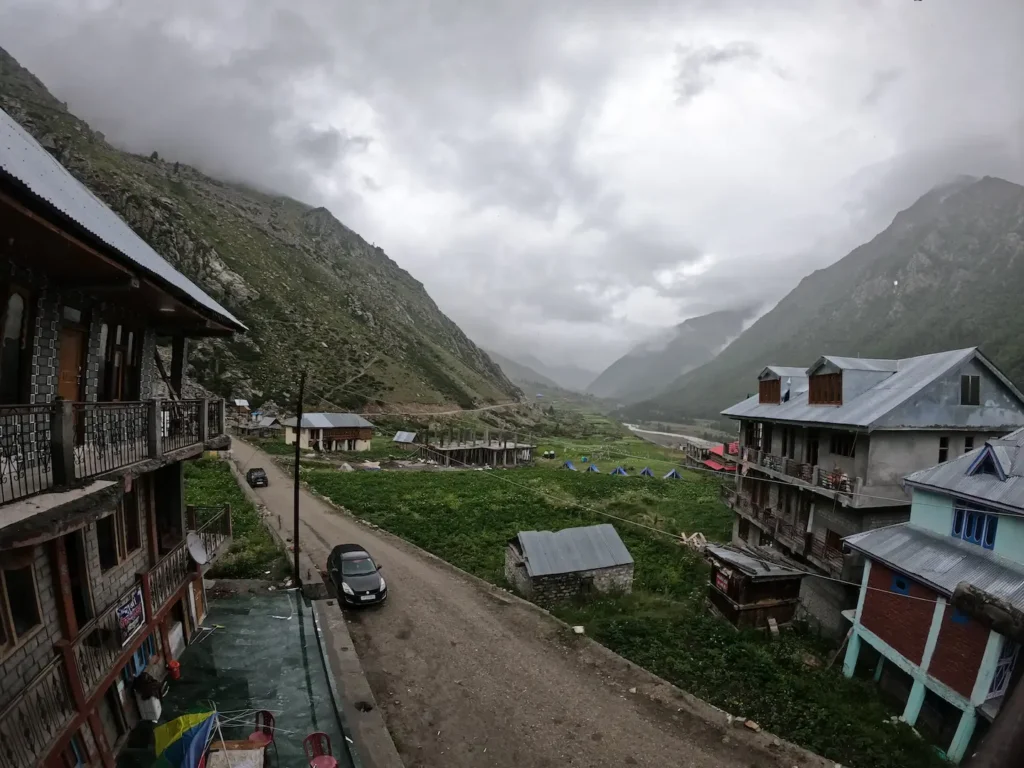
If you plan to visit Chitkul, one of the first things you must consider is the best time to go. Here’s everything you need to know about weather conditions and peak tourist season.
- Summer (April-June): Best time with pleasant weather (10-25°C), but crowded. Great for trekking and camping. Peak Tourist Season.
- Monsoon (July-August): Moderate to heavy rains, misty ambience (5-20°C). Fewer tourists for a serene experience. Chances of Flash floods in the Kinnaur region.
- Autumn (September-November): Mild weather (0-15°C), ideal for outdoor activities and apple picking.
- Winter (December-March): Harsh cold with snowfall, a winter wonderland (sub-zero temperatures). Prepare for potential roadblocks.
Accommodation options in Chitkul

Chitkul offers various accommodation options, catering to various traveller preferences. Visitors can choose from hostels, budget homestays, decent hotels, and camping sites.
Hostels: Chitkul boasts a selection of hostels perfect for budget-conscious travellers or those seeking a communal atmosphere. These hostels provide affordable and basic lodging options, ideal for backpackers and solo adventurers.
Budget Homestays: For a more immersive experience, budget homestays are readily available. Staying with local families allows travellers to experience the culture and traditions of the region while enjoying comfortable yet affordable accommodations.
Decent Hotels: Travelers looking for higher comfort and amenities can find decent hotels in Chitkul. These establishments offer various services and facilities, ensuring a pleasant and convenient stay.
Camping: Stunning natural surroundings make it a fantastic location for camping enthusiasts. Camping sites in and around the area offer an opportunity to connect with nature and enjoy the breathtaking landscapes while being closer to the great outdoors.
In summary, Chitkul provides various accommodation options, from hostels and budget homestays to decent hotels and camping sites, allowing travellers to tailor their stay to their preferences and budgets.
Some tips to keep in mind while choosing accommodation in Chitkul:
- Book in advance: It is a popular tourist destination, and booking your accommodation well is advisable to avoid any last-minute hassles.
- Check for amenities: Depending on your budget and preferences, check if the accommodation offers basic amenities like hot water facilities, room service, WiFi connectivity, etc.
- Location: If you want to stay close to the village centre or any specific attractions, choose a conveniently located accommodation.
- Read reviews: Before making a reservation, read reviews of the accommodation on various travel websites to get an idea of previous guests’ experiences.
Stay Options in Chitkul
- LAP Stays – Wanderer’s Nest
- Zostel Chitkul
- Panaash Eco World (Glamping Dome)
- Dolma Guest Inn
- Samaa Resorts, Chitkul
To know in detail about these options, click on the name.
No matter which accommodation option you choose, staying in Chitkul will be an unforgettable experience. So, pack your bags and immerse yourself in this enchanting village’s serene beauty.
Things to do

Chitkul has a rich cultural heritage that can be explored through various activities. Here are some of the top things to do.
- Visiting local villages:
One of the best ways to glimpse the local way of life is by visiting nearby villages like Rakchham and Sangla. These villages offer a unique insight into traditional Himachali architecture, lifestyle, and culture. You can interact with locals, try their homemade food and even stay at homestays for an authentic experience. - Trying local cuisine:
Every trip to Chitkul is complete with indulging in its delicious local cuisine. Due to its proximity to Tibet, the food here has a strong Tibetan influence. Some must-try dishes include Thukpa (noodle soup), Momos, and Siddu (stuffed bread). You can also try the local delicacy of Trout fish freshly caught from the Baspa River. - Visiting Chitkul Fort:
The ancient Fort is one of the main attractions in the village, believed to be over 500 years old. It offers panoramic views of the surrounding valley. It houses a small temple dedicated to Goddess Mathi Devi, who is believed to be the protector of Chitkul. - Cultural activities:
The village has several festivals and fairs annually, offering insight into the local culture and traditions. Some popular festivals include the Fulaich Fair, Phulech Fair, and Kinnour Dance Festival, where you can witness colourful folk dances and music performances and participate in cultural activities.
Adventure Activities
- Trekking:
Chitkul is a paradise for trekkers, with various trails catering to different expertise levels. The most popular trek here is the short but challenging Kinner Kailash Parikrama, which takes you around the sacred mountain believed to be Lord Shiva’s abode. You can also embark on longer treks like Lamkhaga Pass Trek or Borasu Pass Trek for a more immersive experience in the region’s natural beauty. - Camping:
Camping in Chitkul is a must-do activity to experience the beauty of this small village. There are various campsites along the Baspa River where you can spend a night under the starry sky and wake up to stunning views of the mountains. It is an excellent way to disconnect from city life and immerse yourself in nature. - Nature walks:
Chitkul offers several easy walking trails to soak the village’s natural beauty. You can stroll along the Baspa River, walk through apple and apricot orchards, or hike up to nearby viewpoints for stunning views of the valley.
Chitkul offers an ideal blend of adventure, nature, culture, and spirituality, making it a must-visit destination in Himachal Pradesh. So, plan a trip to this beautiful village and indulge in these activities for an unforgettable experience.
Exploring the culture and heritage of Chitkul
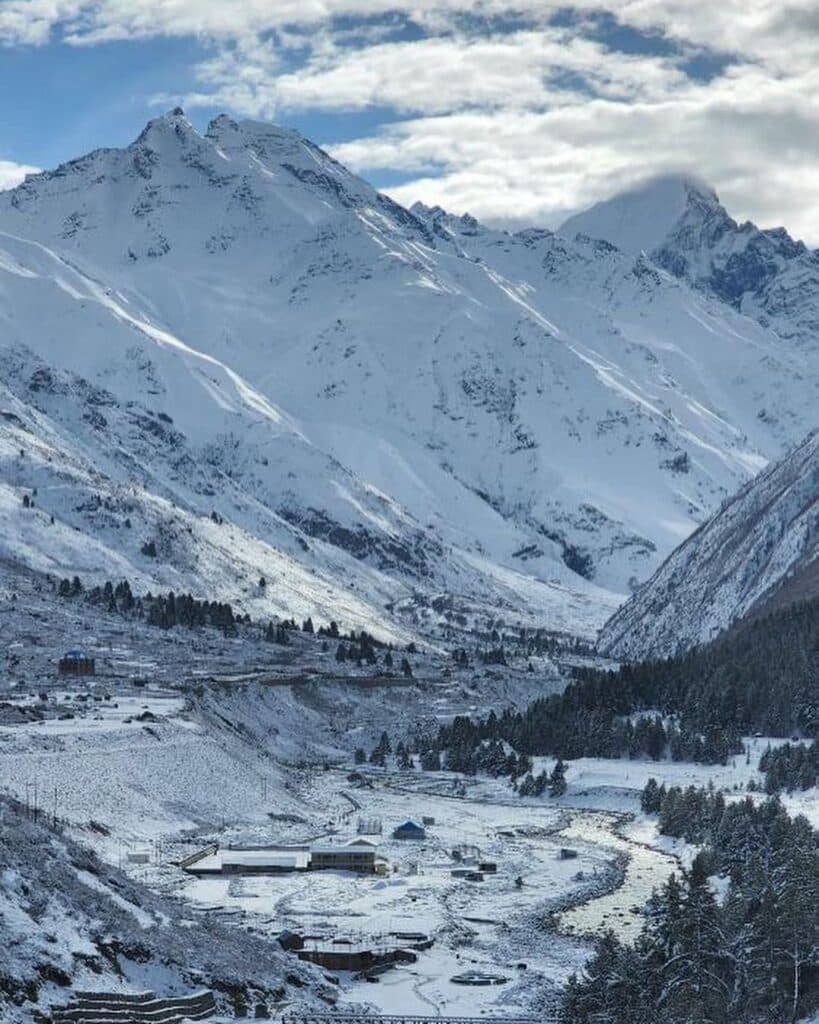
One of the most fascinating aspects of Chitkul’s culture is its traditional festivals, which are celebrated with great enthusiasm and zeal. One such festival is Fulaich, which marks the beginning of the agricultural season in March. Farmers offer prayers for a bountiful harvest during this festival and perform folk dances to express their joy and gratitude towards nature.
Another significant festival celebrated in Chitkul is Sazo, which falls in September or October. It is dedicated to Goddess Durga, who is believed to protect the villagers from evil spirits. The highlight of this festival is the extravagant procession where villagers dress up in traditional attire and carry idols on palanquins while dancing to folk music.
Apart from these major festivals, many other smaller celebrations throughout the year give an insight into the local culture and traditions. One such example is Phagli (also known as Faguli), a winter festival celebrated by locals with bonfires, singing, dancing and feasting on local delicacies.
The traditional cuisine of Chitkul is another aspect that showcases its culture and heritage. The local dishes are simple yet flavourful, made with locally sourced ingredients such as lentils, buckwheat and barley. Some popular dishes include siddu (steamed bread stuffed with lentils), thukpa (noodle soup) and patande (pancakes).
Nearby Places To Visit When In Chitkul

While there are plenty of things to do and see in Chitkul, many nearby places are worth exploring. Here are some of the top nearby places to visit when in Chitkul.
Kinnaur Region
1. Sangla Valley:
Located just 24 kilometres from Chitkul, Sangla Valley is known for its picturesque views and serene atmosphere. It is situated at an altitude of 2,700 meters above sea level and offers impressive views of the Kinnaur Kailash range. The valley is dotted with apple orchards, pine forests, gushing rivers, and traditional wooden houses, which make it a perfect place for nature walks and hikes.
2. Rakcham Village:
Rakcham Village is another nearby gem that should not be missed when visiting Chitkul. It is 13 kilometres from Chitkul and can be reached via a scenic drive through lush green valleys and meadows. This quaint village offers panoramic views of the Baspa River flowing alongside it, as well as the majestic Himalayan peaks in the background.
3. Kalpa:
Kalpa is a small town located around 45 kilometres from Chitkul, which offers spectacular views of the Kinner Kailash range, including the Shivling peak, one of the mythical abodes of Lord Shiva. It is also known for its apple orchards and traditional Kinnauri architecture. The town is also home to the ancient Narayan-Nagini Temple, a popular pilgrimage site.
4. Kinnaur Wildlife Sanctuary:
About 50 kilometres from Chitkul, Kinnaur Wildlife Sanctuary is a paradise for wildlife enthusiasts. The sanctuary is home to various animal species, such as snow leopards, musk deer, Himalayan black bears, and many more. Visitors can also enjoy trekking and camping activities within the sanctuary.
5. Chandika Devi Temple:
Chandika Devi Temple is a famous religious site around 6 kilometres from Chitkul. It is dedicated to Goddess Chandika, who is believed to be an incarnation of Goddess Kali. The temple offers beautiful views of the surrounding valleys and mountains and attracts many devotees annually.
Spiti Region
6. Nako:
Nako is a small village located about 106 kilometres from Chitkul. It is one of the highest inhabited villages in the Himalayas. The location offers stunning views of the snow-covered peaks, crystal clear lakes, and traditional mud-brick houses. It is also home to an ancient monastery called Nako Monastery, which attracts many visitors.
7. Tabo:
Tabo is a small town situated around 160 kilometres from Chitkul. It is famous for its ancient Tabo Monastery, which dates back over 1000 years. The monastery is known for its beautiful murals, intricate wood carvings, and ancient scriptures. Tabo also offers breathtaking views of the Spiti River and surrounding landscapes.
8. Kaza:
Kaza is a scenic town situated around 230 kilometres from Chitkul. It is known as the base for exploring the Spiti Valley. It is surrounded by towering mountains, barren landscapes, and ancient monasteries. Some must-visit places in Kaza include Key Monastery, Kibber Village, Pin Valley National Park, and Komik Village.
9. Shimla:
Shimla, the capital city of Himachal Pradesh, is located around 250 kilometres from Chitkul and can be reached by road or train. This famous hill station perfectly blends colonial charm and natural beauty. Some must-visit attractions in Shimla include the Ridge, Mall Road, Christ Church, and Jakhu Temple.
10. Narkanda:
Narkanda is a scenic hill station situated around 225 kilometres from Chitkul. It is known for its apple orchards, skiing slopes, and stunning views of the Himalayan peaks. Some must-visit places in Narkanda include Hatu Peak, Tani Jubbar Lake, and Stokes Farm.
These are some of the top nearby places to visit when in Chitkul. Each of these places has its own unique charm and offers something different to visitors. Include these destinations in your itinerary for an unforgettable trip to Chitkul.
5-day itinerary for Chitkul
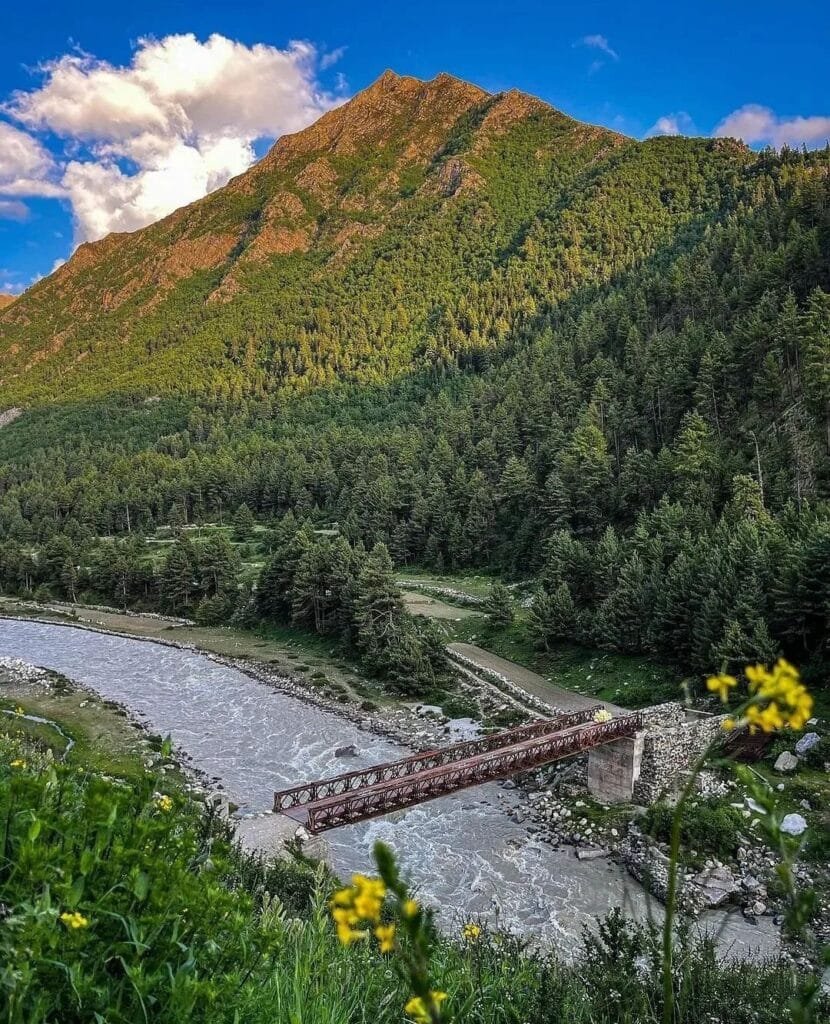
1: Arrival in Chitkul
- Start your journey in the evening by taking an overnight bus from Delhi to Chitkul.
- Arrive in Chitkul early in the morning.
- Check in to your chosen accommodation and rest for a while.
- After freshening up, explore the beautiful Chitkul village.
- Enjoy a local meal at one of the village’s eateries.
- Overnight stay in Chitkul.
2: Sangla Valley Exploration
- After breakfast, head to Sangla Valley (around 20 kilometres from Chitkul).
- Visit Kamru Fort and the Kamaksha Devi Temple.
- Explore the charming Sangla village and its market.
- Return to Chitkul in the evening.
- Overnight stay in Chitkul.
3: Adventure Day
- Today, embark on a trek or go camping in the scenic surroundings. You can explore places like Rakcham or go on a trek to Nagasthi.
- Enjoy the breathtaking natural beauty and capture some stunning photographs.
- Return to Chitkul in the evening.
- Overnight stay in Chitkul.
4: Explore Kalpa
- Check out from your accommodation in Chitkul.
- Leave for Kalpa, which is about a 2-hour drive from Chitkul.
- Explore the picturesque town of Kalpa, known for its stunning views of the Kinner Kailash range.
- Visit the Kalpa Monastery and enjoy the serene ambience & Roghi Suicide Point.
- Overnight stay in Kalpa.
5: Return to Delhi
- Check out from your accommodation.
- Catch a bus back to Delhi in the evening from Reckong Peo.
- Arrive in Delhi in the evening or the following day, completing your Chitkul adventure.
Please note that this itinerary is a general guideline and can be customized based on your interests and the specific bus schedules available for your trip. Book your accommodation and transportation in advance, especially during peak tourist seasons.
Conclusion
In conclusion, Chitkul is a hidden Himalayas gem offering breathtaking views and unique cultural experiences.
This village has something for every traveller, from pristine landscapes to warm hospitality.
With this ultimate travel guide, you can easily plan your trip to Chitkul and make the most of your visit. So pack your bags and prepare to embark on an unforgettable journey through one of India’s most charming destinations – Chitkul!
FAQs
Chitkul is famous for being one of India’s most picturesque and remote villages. Its stunning natural beauty, high-altitude location in the Himalayas, and the Baspa River flowing through it make it a popular destination for nature enthusiasts, trekkers, and those seeking a tranquil escape.
Chitkul is often called the “last village” because it is the last inhabited village on the Indo-Tibetan border in the Kinnaur district of Himachal Pradesh. Beyond Chitkul, the region becomes too harsh and inhospitable for human settlement, making it the final accessible village in the area.
The best time to visit Chitkul is during the summer, from May to June when the weather is pleasant and the meadows are in full bloom. September and early October are also ideal, offering clear skies and the added beauty of autumn colours. However, Chitkul is not easily accessible during the winter months due to heavy snowfall.
Chitkul is worth a visit for its breathtaking natural beauty, serene environment, and the opportunity to experience life in a remote Himalayan village. The village offers trekking routes, lush landscapes, and an authentic cultural experience. Suppose you’re a nature lover or seek a peaceful getaway. In that case, Chitkul is a destination you want to take advantage of.
Did you like this travel guide for Chitkul?
We have 100s more such guides on similar off-beat experiences & we send out such guides, offers, hidden gems, and trekking destinations weekly via email. Subscribe to our newsletter to get them directly into your inbox.
